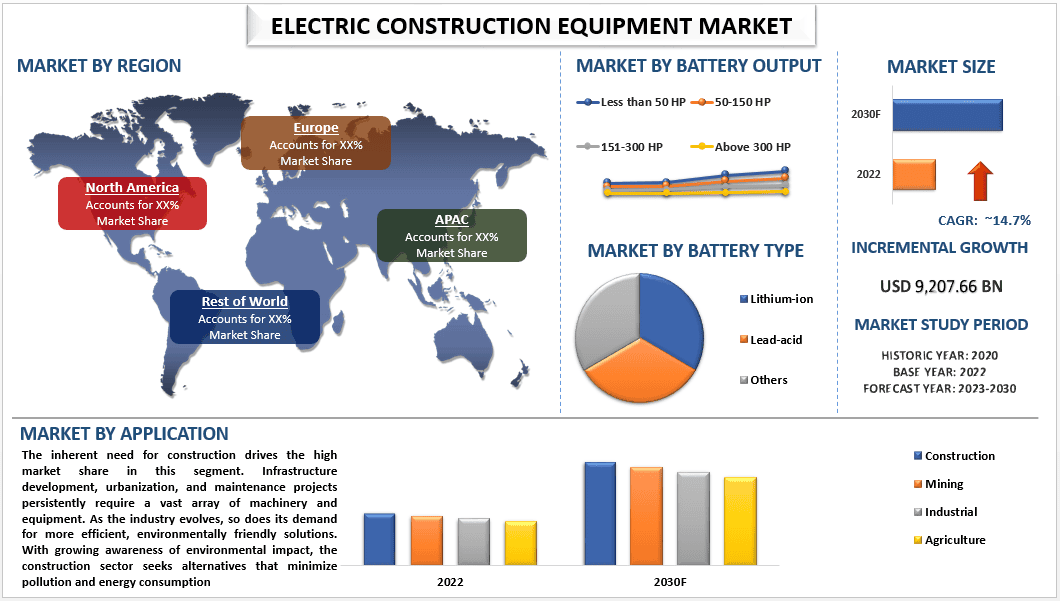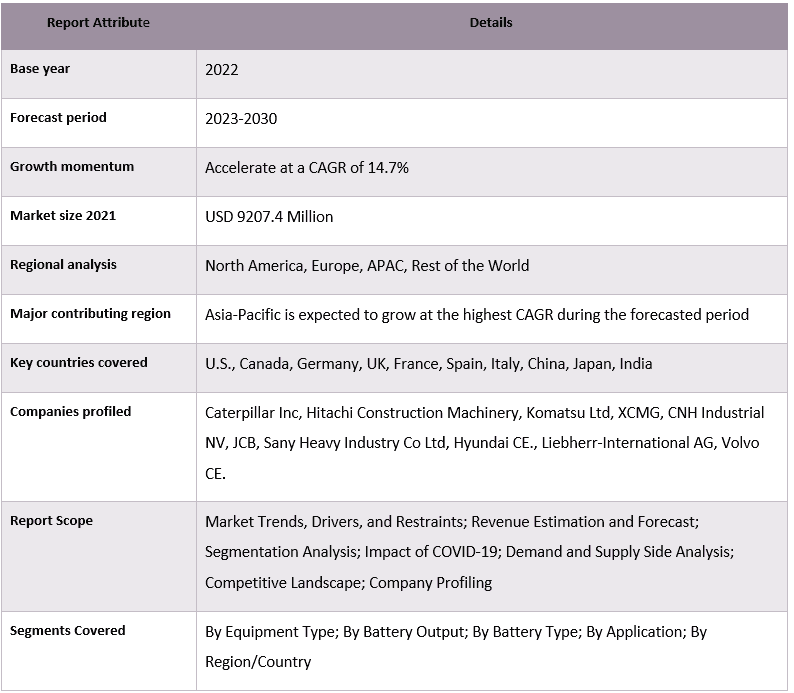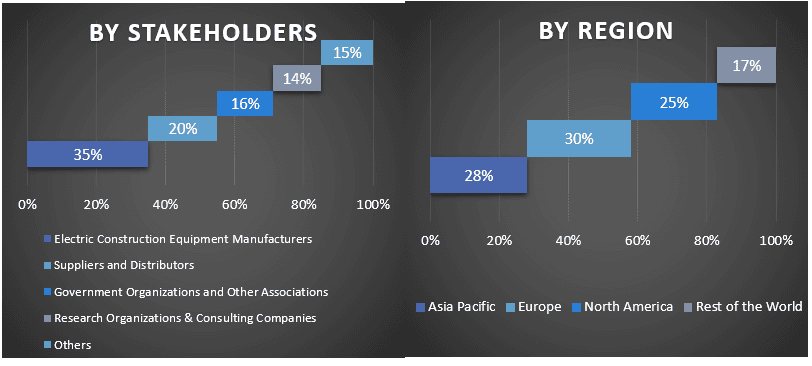- Home
- About Us
- Industry
- Services
- Reading
- Contact Us
Electric Construction Equipment Market: Current Analysis and Forecast (2022-2030)
Emphasis on Equipment Type (Electric Excavators, Electric Earth Mover, Electric Wheel Loader, Electric Asphalt Equipment and Others); Battery Output (Less Than 50 Hp, 50-150HP, 151-300HP and Above 300HP); Battery Type (Lithium Ion, Lead Acid and Others); Application (Construction, Mining, Industrial, Agriculture); and Region/Country

The Electric Construction Equipment Market is expected to grow at a strong CAGR of 14.72% during the forecast period 2023-2030. The global construction industry has witnessed a significant surge in the adoption of electric construction equipment, driven by the dual goals of reducing emissions and improving operational efficiency. This transition is evident in major construction markets, with substantial investments in USD flowing into this sector. For instance, in 2022, the United States allocated over $200 million for research and development of electric construction machinery, aiming to spur innovation and create a more sustainable industry. Similarly, industry giants have made substantial commitments to electrify their fleets, such as a renowned construction firm’s $1 billion investment in 2021 to replace diesel-powered machinery with electric alternatives. These instances underscore the accelerating shift towards electric construction equipment, with tangible financial backing, highlighting a greener and more technologically advanced future for the industry.
Some of the major players operating in the market include Caterpillar Inc, Hitachi Construction Machinery, Komatsu Ltd, XCMG, CNH Industrial NV, JCB, Sany Heavy Industry Co Ltd, Hyundai CE., Liebherr-International AG, Volvo CE.
Insights Presented in the Report
“Based on the equipment type, the market has been segmented into electric excavators, electric earth mover, electric wheel loader, electric asphalt equipment and others. Among them, electric earth mover segment held a considerable share of the market in 2022.”
Based on the equipment type, the market has been segmented into electric excavators, electric earth mover, electric wheel loader, electric asphalt equipment and others. Among them, electric earth mover segment held a considerable share of the market in 2022. Electric earthmovers are gaining popularity in the construction sector, by their improved performance and environmental benefits. These electric behemoths offer powerful and precise digging capabilities while being environmentally friendly with zero exhaust emissions. The electric earthmovers’ regenerative braking systems also enhance energy efficiency, allowing for prolonged usage on job sites without the need for frequent recharging.
“Based on the Battery type, the market is segmented into lithium ion, lead acid and others. Among these, the others is having a high market share in 2022.”
Based on the Battery type, the market is segmented into lithium ion, lead acid and others. Among these, the others is having a high market share in 2022. The electric construction equipment industry is also witnessing growing interest in solid-state batteries, although they are still in the early stages of commercialization. One of the factors driving this interest is safety. Solid-state batteries, with their solid electrolytes and lack of flammable components, offer enhanced safety features compared to traditional lithium-ion batteries. Construction sites often involve demanding and hazardous conditions, and the increased safety provided by solid-state batteries is an attractive proposition for equipment manufacturers and construction companies alike. Moreover, solid-state batteries hold promise in improving the overall performance of electric construction equipment.
Electric Construction Equipment Market Report Coverage

“North America will grow with significant CAGR during forecast period.”
The adoption of electric construction equipment in North America has gained substantial momentum, driven by the region’s strong commitment to sustainability and the implementation of stringent emissions regulations. For instance, Caterpillar, a global construction equipment leader, made a significant investment of over $200 million in electric construction equipment by acquiring Epiroc, an established electric machinery manufacturer, in 2021. This strategic move underscored Caterpillar’s dedication to expanding its electric machinery portfolio and emphasized the industry’s transition toward eco-friendly alternatives. Furthermore, prominent construction firms in North America, such as Turner Construction, are proactively integrating electric construction equipment into their operations. Turner Construction, in particular, invested approximately $1.5 million in 2020 to introduce a fleet of electric mini excavators. This significant financial commitment demonstrates the company’s determination to reduce emissions, minimize environmental impact, and promote sustainable construction practices.
Reasons to buy this report:
- The study includes market sizing and forecasting analysis validated by authenticated key industry experts.
- The report presents a quick review of overall industry performance at one glance.
- The report covers an in-depth analysis of prominent industry peers with a primary focus on key business financials, product portfolios, expansion strategies, and recent developments.
- Detailed examination of drivers, restraints, key trends, and opportunities prevailing in the industry.
- The study comprehensively covers the market across different segments.
- Deep dive regional level analysis of the industry.
Customization Options:
The global electric construction equipment market can further be customized as per the requirement or any other market segment. Besides this, UMI understands that you may have your own business needs, hence feel free to contact us to get a report that completely suits your requirements.
Table of Content
Research Methodology for the Electric Construction Equipment Market Analysis (2023-2030)
Analyzing the historical market, estimating the current market, and forecasting the future market of the global electric construction equipment market were the three major steps undertaken to create and analyze the adoption of Electric Construction Equipment in major regions globally. Exhaustive secondary research was conducted to collect the historical market numbers and estimate the current market size. Secondly, to validate these insights, numerous findings and assumptions were taken into consideration. Moreover, exhaustive primary interviews were also conducted, with industry experts across the value chain of the global electric construction equipment market. Post assumption and validation of market numbers through primary interviews, we employed a top-down/bottom-up approach to forecasting the complete market size. Thereafter, market breakdown and data triangulation methods were adopted to estimate and analyze the market size of segments and sub-segments of the industry pertains to. Detailed methodology is explained below:
Analysis of Historical Market Size
Step 1: In-Depth Study of Secondary Sources:
Detail secondary study was conducted to obtain the historical market size of the electric construction equipment market through company internal sources such as annual reports & financial statements, performance presentations, press releases, etc., and external sources including journals, news & articles, government publications, competitor publications, sector reports, third-party database, and other credible publications.
Step 2: Market Segmentation:
After obtaining the historical market size of the electric construction equipment market, we conducted a detailed secondary analysis to gather historical market insights and share for different segments & sub-segments for major regions. Major segments are included in the report by equipment type, battery output, battery type, and application. Further country-level analyses were conducted to evaluate the overall adoption of testing models in that region.
Step 3: Factor Analysis:
After acquiring the historical market size of different segments and sub-segments, we conducted a detailed factor analysis to estimate the current market size of the electric construction equipment market. Further, we conducted factor analysis using dependent and independent variables such as equipment type, battery output, battery type, and application of the electric construction equipment market. A thorough analysis was conducted of demand and supply-side scenarios considering top partnerships, mergers and acquisitions, business expansion, and product launches in the electric construction equipment market sector across the globe.
Current Market Size Estimate & Forecast
Current Market Sizing: Based on actionable insights from the above 3 steps, we arrived at the current market size, key players in the global electric construction equipment market, and market shares of the segments. All the required percentage shares split, and market breakdowns were determined using the above-mentioned secondary approach and were verified through primary interviews.
Estimation & Forecasting: For market estimation and forecast, weights were assigned to different factors including drivers & trends, restraints, and opportunities available for the stakeholders. After analyzing these factors, relevant forecasting techniques i.e., the top-down/bottom-up approach were applied to arrive at the market forecast for 2028 for different segments and sub-segments across the major markets globally. The research methodology adopted to estimate the market size encompasses:
- The industry’s market size, in terms of revenue (USD) and the adoption rate of the electric construction equipment market across the major markets domestically
- All percentage shares, splits, and breakdowns of market segments and sub-segments
- Key players in the global electric construction equipment market in terms of products offered. Also, the growth strategies adopted by these players to compete in the fast-growing market
Market Size and Share Validation
Primary Research: In-depth interviews were conducted with the Key Opinion Leaders (KOLs) including Top Level Executives (CXO/VPs, Sales Head, Marketing Head, Operational Head, Regional Head, Country Head, etc.) across major regions. Primary research findings were then summarized, and statistical analysis was performed to prove the stated hypothesis. Inputs from primary research were consolidated with secondary findings, hence turning information into actionable insights.
Split of Primary Participants in Different Regions

Market Engineering
The data triangulation technique was employed to complete the overall market estimation and to arrive at precise statistical numbers for each segment and sub-segment of the global electric construction equipment market. data was split into several segments & sub-segments post studying various parameters and trends in the areas of the equipment type, battery output, battery type, and application in the global electric construction equipment market.
The main Objective of the Global Electric Construction Equipment Market Study
The current & future market trends of the global electric construction equipment market were pinpointed in the study. Investors can gain strategic insights to base their discretion for investments on the qualitative and quantitative analysis performed in the study. Current and future market trends determined the overall attractiveness of the market at a regional level, providing a platform for the industrial participant to exploit the untapped market to benefit from a first-mover advantage. Other quantitative goals of the studies include:
- Analyze the current and forecast market size of the electric construction equipment market in terms of value (USD). Also, analyze the current and forecast market size of different segments and sub-segments.
- Segments in the study include areas of the equipment type, battery output, battery type, and application.
- Define and analysis of the regulatory framework for the electric construction equipment industry.
- Analyze the value chain involved with the presence of various intermediaries, along with analyzing customer and competitor behaviors of the industry.
- Analyze the current and forecast market size of the electric construction equipment market for the major region.
- Major countries of regions studied in the report include Asia Pacific, Europe, North America, and the Rest of the World
- Company profiles of the electric construction equipment market and the growth strategies adopted by the market players to sustain in the fast-growing market.
- Deep dive regional level analysis of the industry
Related Reports
Customers who bought this item also bought










